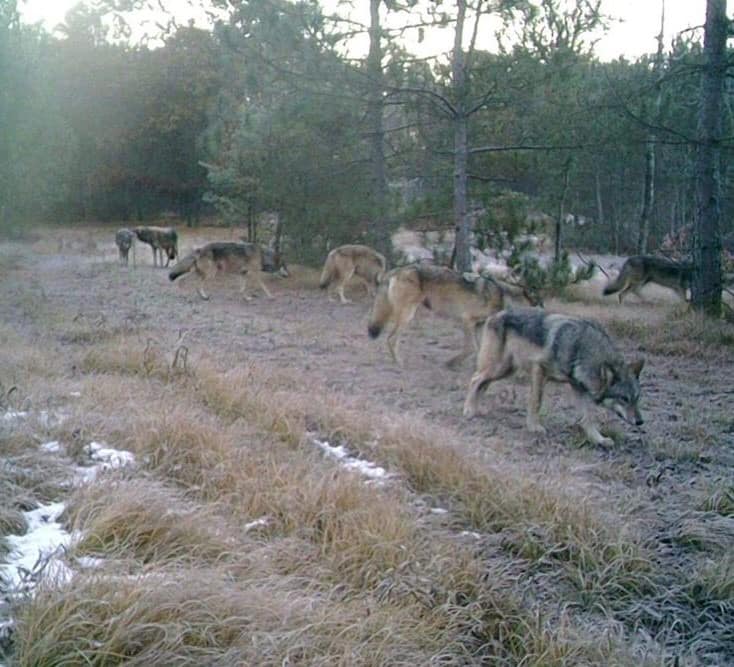Gray wolves are now responsible for killing more white-tailed deer in four counties of one Great Lakes state than annual the number of deer killed by gun-hunters, according to data released this week by a state group.
The unmanaged proliferation of wolves is directly linked to the efforts of two anti-hunting organizations that have routinely used Federal judges to stop the scientific-based management of the animals. The Wisconsin population is now 5 times greater than the original population goal set by state biologists — and agreed to by the U.S. Fish and Wildlife Service — more than 20 years ago.

In the 2019 Wisconsin example, gray wolves (also known as timber wolves) were responsible for 31% of all deer killed by either human hunters or timber wolves in Wisconsin’s entire North Woods, which encompasses several million acres across 17 counties. In 2019 alone, an estimated 48,851 deer were killed — 33,571 by gun-hunters and 15,280 by wolf predation in the following counties: Iron, Ashland, Douglas, Forest, Vilas, Sawyer, Price, Bayfield, Lincoln, Florence, Oneida, Langlade, Burnett, Rusk, Taylor, Washburn, Marinette and Oconto. The data was released this week by the group called Wisconsin Wolf Facts.
Wolves killed more deer than did hunters in Iron, Jackson, Douglas and Forest counties. The heaviest predation occurred in Douglas County, where wolves killed an estimated 2,260 whitetails. Gun-hunters in that county only took home 1,790 deer this year.
Wolves were responsible for another 12% of deer killed (2,780 whitetails) in the central counties of Jackson, Wood, Juneau, Clark, Eau Claire, Adams and Monroe.
HISTORY OF WOLVES IN WISCONSIN:
1800: Wisconsin’s pre-settlement landscape is home to an estimated 4,500 eastern timber wolves.
1848: Wisconsin becomes the 30th state.
1865: State declares a bounty on wolves.
1957: Bounty program ends.
1960: Wolves considered extirpated from Wisconsin.
1967: U.S. Fish and Wildlife Service designates the eastern timber wolf as a federally endangered species.
1975: Several wild wolves disperse from Minnesota and move into northern Wisconsin.
1980: Wisconsin wolf population is estimated at 25 animals in five packs.
1999: Wisconsin DNR unveils management plan that calls for a population goal of 250 wolves. Plan includes a provision for delisting wolves once this number is reached.
2003: Federal government reclassifies wolves from endangered to threatened in Wisconsin.
2004: Wisconsin’s wolf population reaches 373 animals. Wolves are removed from the state’s list of threatened species.
2004: Two anti-hunting organizations file a federal lawsuit that challenges Wisconsin’s delisting of wolves.
2005: Federal judge sides with anti-hunting organizations and reclassifies Wisconsin’s wolves as threatened.
2011: More than 200 packs of wolves roam Wisconsin, with an estimated population of 825 animals.
2012: Wolves delisted in Wisconsin. Wisconsin DNR drafts framework for a hunting and trapping season aimed to reduce the population by 14% (about 200). Tribal members are awarded 42% of the overall tags. The state issues 1,160 wolf hunting/trapping licenses to the general public, as biologists estimate a 10% success rate among the general public.
2012-2013: Hunters and trappers harvest 243 animals during Wisconsin’s first wolf season. The total harvest is comprised of 59% males and 41% females. Trappers account for 52% of the total harvest.
2013: The state sells applications to 16,672 hunters/trappers and awards 2,510 permits. The statewide quota is 275 wolves, with 251 of these tags available to state license holders.
2013: Wisconsin hunters and trappers harvest 257 wolves in the state’s second wolf season. Of the animals taken, 134 were males, 123 females. Trappers account for 70% of the harvest (180 animals).
2014: Anti-hunters file anohter federal lawsuit, calling for Wisconsin wolves to be placed back on the endangered list. Federal judge sides with anti-hunters and grants the protection. David Mech, a wolf expert for the U.S. Geological Survey, told the Star Tribune he was perplexed by the court ruling because it runs against ample scientific evidence that wolves are not endangered in Michigan, Minnesota and Wisconsin. “It sure is going to surprise a lot of people, especially wolf biologists,’’ said Mech, who has studied wolves for 56 years and provided testimony the last time wolves in the region were removed from Endangered Species Act protections.
2014: Wisconsin’s wolf population is estimated at 747 animals.
2017: Wisconsin’s wolf population is estimated at 925 animals.
2018: Wisconsin’s wolf population is estimated at 978 animals.
2019: Wolves kill more deer than do gun-deer hunters in four Wisconsin counties. Wolves are also responsible for more than 31% of the white-tailed deer (15,280) killed in the 17 counties that comprise Wisconsin’s “North Woods.”


GRAY WOLF FACTS:
•There are more than 60,000 gray wolves in Canada.
•The U.S. is home to about 20,000 gray wolves.
•Nearly one-third of all the gray wolves in the U.S. lives in three states: Minnesota, Wisconsin and Michigan.
•On average, one gray wolf will eat 20 white-tailed deer per year.
•Wolf population control has been a political football ever since the states agreed to reintroduce the animals to the North woods decades ago Wisconsin’s first wolf hunting and trapping season took place in 2013, but was quickly halted by Federal judges when lawsuits were filed by the Humane Society of the United States and The Fund for Animals — two anti-hunting organizations.
READ MORE:
DON’T BELIEVE THE LIES: WOLVES ARE NOT ENDANGERED
WOLF PREDATION ON LIVESTOCK ON DRAMATIC RISE
WOLVES WIPE OUT FAMILY’S SHEEP FARM IN ONE NIGHT
STATE RESIDENTS CALL FOR AN END TO WOLF ENDANGERED STATUS
